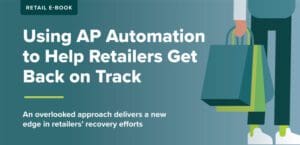In response to the challenges and changing buying behaviors stemming from the COVID-19 pandemic, most retailers have prioritized automation efforts for front-of-store to streamline ordering, fulfillment, and improve their customer experience. But the potential for automation in retail extends far beyond these client touchpoints.
According to Deloitte’s 2022 Retail Industry Outlook report, retailers are now focusing on workforce retention, supply chain resiliency, and digital investments. Automation across the back office, specifically in AP, can help retailers in these areas by enabling remote or hybrid teams to work effectively, enabling consistent on-time vendor payments to keep critical goods and services flowing.
No surprise then that AP remains the top finance automation priority for retailers for the second year in a row, according to the 2022 State of AP report. But don’t just take our word for it. Today’s blog shares 8 reasons why 80% of retailers are zeroing in on AP as their top finance automation priority this year.
What is AP Automation in Retail
AP Automation is the automated process of capturing, coding, and approving invoices, paying vendors, and managing expenses. For retailers competing amidst a fierce business landscape, organizations must respond to emerging trends quickly in order to meet consumer demands. Serving customers and keeping shelves stocked requires retailers to navigate and maintain a complex web of vendors. By cutting down payment timelines and errors, AP automation boosts vendor relationships, which in turn gives retailers a sharper competitive edge.
8 Reasons Why Retailers Need AP Automation
1. Reduced Fraud Risk
The Association of Financial Professionals’ 2021 Payments Fraud and Control Survey Report reported that 74% of respondents were targets of an attempted or actual payment fraud attack. Although checks are the payment method most susceptible to fraud, one fourth of retailers surveyed in this year’s State of AP report are still making more than half of their payments via check. AP automation can minimize the risk of fraud by reducing or replacing paper checks with more secure ACH and virtual card transactions.
2. Fewer Errors and Faster Invoice Processing
Growing invoice volumes for retailers can overwhelm teams that are already understaffed. Outdated finance processes that are unable to scale efficiently can lead to missed discount windows, increased errors, and late payment rates. Meanwhile, PYMNTS’s January 2022 AP Automation Tracker reported that companies with automated AP functions reported 71% fewer errors than those relying on paper-based methods.
3. Stronger Vendor Relationships
According to the 2022 State of AP report, 85% of retail respondents classified vendor relationships as being more important than ever. With global supply chain issues already causing major production or delivery issues, retailers must be careful to maintain strong relationships with their strategic suppliers or risk losing them. AP automation’s ability to enable consistent, on-time payment using vendors’ preferred payment method can secure these critical relationships.
4. Save Costs and Score Cash Back Rebates
In this year’s State of AP report, retailers were two times more likely to list missed discount windows as a primary AP pain point compared with respondents from other industries. Virtual cards are the fastest form of payment for vendors and simplify reconciliation processes since payment and remittance are delivered at the same time – not the case with ACH. While checks wrack up printing and postage costs (not to mention the time spent preparing payments), virtual cards and other forms of electronic payment are a strategic solution that improve finance processes while paying retailers valuable cash back rebates.
5. Make Payments Faster
It is not uncommon for retail AP teams to spend the bulk of their time on manual, paper-based invoice processes. Full invoice-to-pay automation capabilities can capture and code invoices with far fewer errors than manual data entry and significantly reduce the time spent processing invoices. Faster, more efficient processes free finance teams to focus on higher value work that truly makes a difference.
6. Better forecasting and cash flow management
Many retailers today (especially those managing multiple locations) have poor visibility into their AP spend and cash flow at the store-level. Automating AP does away with this limited view and provides clear insights that retailers can use for business decisions with respect to their payments, vendors, and manage cash flow.
7. Alleviate Staffing Issues
Today’s competitive labor market has caused an accounting shortage and made AP headcount increasingly expensive and difficult to source. In turn, the alternative of using AP automation grows ever-more compelling for leadership teams. Aside from reducing the headcount needed to manage the growing number of invoices, AP automation frees staff from the burdens once associated with manual AP. This enables them to be more productive, engaged, and focused on helping the company succeed.
8. Enable a Hybrid Work Model
Gone are the days of needing employees to be in a central office to approve invoices or print and send checks. AP automation allows AP staff to review and approve invoices or pay vendors anywhere and using any device. Similarly, month-end closing and AP audit data can also be accessed remotely, further eliminating the need for remote staff to be in an office or a store.
Automating Accounts Payable in Retail
Looking to learn more about how AP automation is giving a new edge to retailers’ recovery efforts in a post COVID-19 world? Download our eBook Using AP Automation to Help Retailers Get Back on Track to get insights on how today’s top retailers are automating their back offices to cut costs, streamline manual processes, and modernize their finance organizations.





